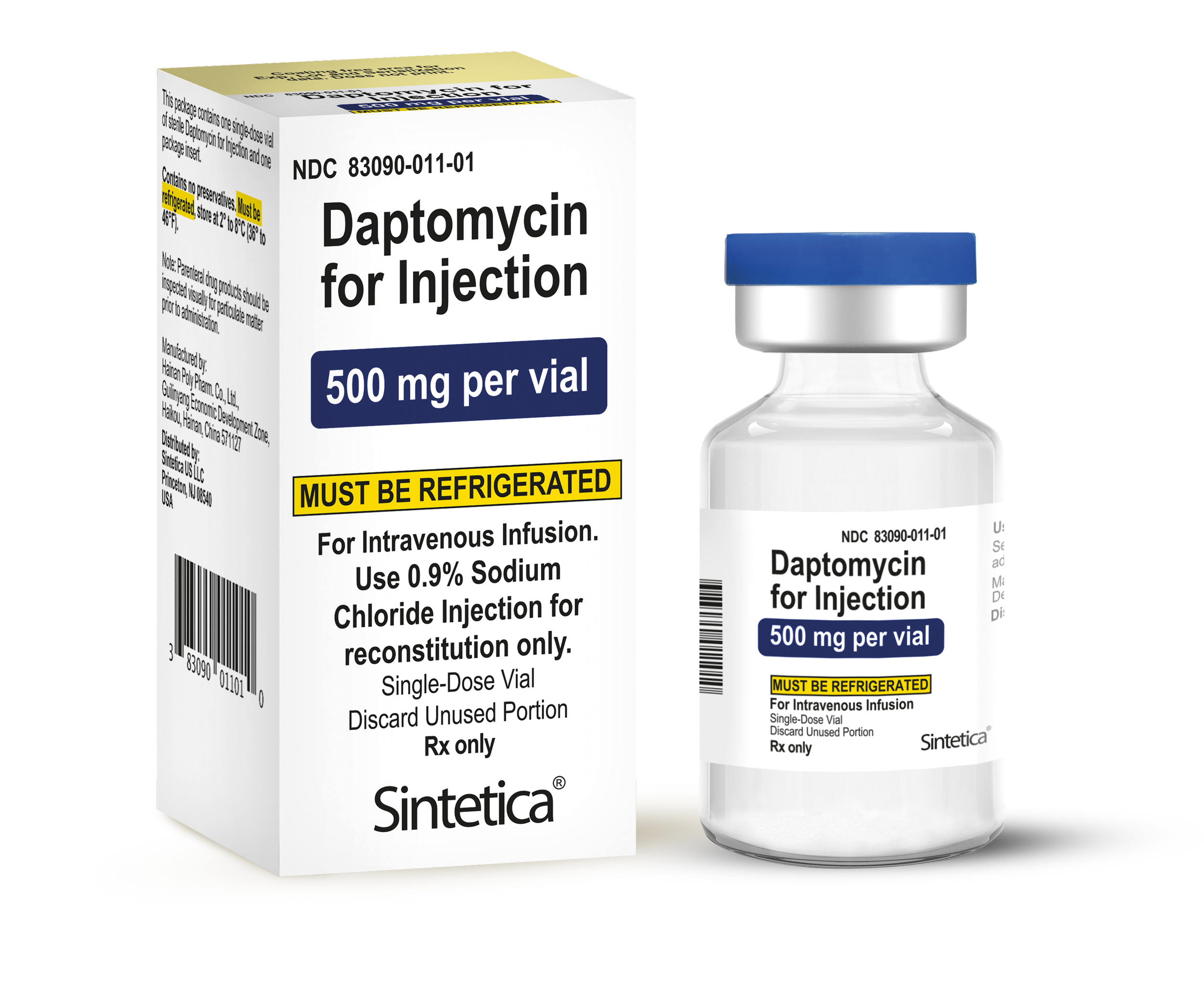
Daptomycin
for Injection
For Intravenous Use. 500 mg lyophilized powder for reconstitution in a single-dose vial.
Daptomycin for injection is a lipopeptide antibacterial indicated for the treatment of:
Complicated skin and skin structure infections (cSSSI) in adult and pediatric patients (1 to 17 years of age)
Staphylococcus aureus bloodstream infections (bacteremia), in adult patients including those with right-sided infective endocarditis
Staphylococcus aureus bloodstream infections (bacteremia) in pediatric patients (1 to 17 years of age)
Flip-off seal
Sulfite-free
Preservative-free
Latex-free
Allergen-free
AP-rated
For intravenous use
Must be refrigerated
STORE AT 2°C to 8°C (36°F to 46°F)
Product information
| NDC NUMBER | STRENGTH | UNIT SIZE | PACK QUANTITY | ABC | CARDINAL | MCK | BAR CODED | |
|---|---|---|---|---|---|---|---|---|
 | 83090-011-01 | 500 mg | 500 mg | 1 single-dose vial | 10288183 | 5905559 | 2928505 | ✔ |
Important safety information
DAPTOMYCIN for injection, for lntravenous Use
Limitations of use
Daptomycin for injection is not indicated for the treatment of pneumonia.
Daptomycin for injection is not indicated for the treatment of left-sided infective endocarditis due to S. aureus.
Daptomycin for injection is not recommended in pediatric patients younger than one year of age due to the risk of potential effects on muscular, neuromuscular, and/or nervous systems (either peripheral and/or central) observed in neonatal dogs.
To reduce the development of drug-resistant bacteria and maintain the effectiveness of daptomycin for injection and other antibacterial drugs, daptomycin for injection should be used to treat or prevent infections that are proven or strongly suspected to be caused by bacteria.
Dosage and administration
Adult Patients
Administer to adult patients intravenously in 0.9% sodium chloride, either by injection over a 2-minute period or by infusion over a 30-minute period.
Recommended dosage regimen for adult patients:
Pediatric Patients
Unlike in adults, do NOT administer by injection over a two (2) minute period to pediatric patients.
Administer to pediatric patients intravenously in 0.9% sodium chloride, by infusion over a 30- or 60-minute period, based on age.
Recommended dosage regimen for pediatric patients (1 to 17 years of age) with cSSSI, based on age:
* Recommended dosage is for pediatric patients (1 to 17 years of age) with normal renal function. Dosage adjustment for pediatric patients with renal impairment has not been established.
• Recommended dosage regimen for pediatric patients (1 to 17 years of age) with S. aureus bacteremia, based on age:
* Recommended dosage is for pediatric patients (1 to 17 years of age) with normal renal function. Dosage adjustment for pediatric patients with renal impairment has not been established.
• There are two formulations of daptomycin that have differences concerning storage and reconstitution. Carefully follow the reconstitution and storage procedures in labeling.
• Do not use in conjunction with ReadyMED® elastomeric infusion pumps in adult and pediatric patients.
Dosage forms and strengths
For lnjection: 500 mg lyophilized powder for reconstitution in a single-dose vial.
Contraindications
Known hypersensitivity to daptomycin.
Warnings and precautions
Anaphylaxis/hypersensitivity reactions (including life-threatening): Discontinue daptomycin for injection and treat signs/symptoms.
Myopathy and rhabdomyolysis: Monitor CPK levels and follow muscle pain or weakness; if elevated CPK or myopathy occurs, consider discontinuation of daptomycin for injection.
Eosinophilic pneumonia: Discontinue daptomycin for injection and consider treatment with systemic steroids.
Drug Reaction with Eosinophilia and Systemic Symptoms (DRESS): Discontinue daptomycin for injection and institute appropriate treatment.
Tubulointerstitial Nephritis (TIN): Discontinue daptomycin for injection and institute appropriate treatment.
Peripheral neuropathy: Monitor for neuropathy and consider discontinuation.
Potential nervous system and/or muscular system effects in pediatric patients younger than 12 months: Avoid use of daptomycin for injection in this age group.
Clostridioides difficile-associated diarrhea: Evaluate patients if diarrhea occurs.
Persisting or relapsing S. aureus bacteremia/endocarditis: Perform susceptibility testing and rule out sequestered foci of infection.
Decreased efficacy was observed in adult patients with moderate baseline renal impairment.
Adverse reactions
Adult cSSSI Patients: The most common adverse reactions that occurred in ≥2% of adult cSSSI patients receiving daptomycin for injection 4 mg/kg were diarrhea, headache, dizziness, rash, abnormal liver function tests, elevated creatine phosphokinase (CPK), urinary tract infections, hypotension, and dyspnea.
Pediatric cSSSI Patients: The most common adverse reactions that occurred in ≥2% of pediatric patients receiving daptomycin for injection were diarrhea, vomiting, abdominal pain, pruritus, pyrexia, elevated CPK, and headache.
Adult S. aureus bacteremia/endocarditis Patients: The most common adverse reactions that occurred in ≥5% of S. aureus bacteremia/endocarditis patients receiving daptomycin for injection 6 mg/kg were sepsis, bacteremia, abdominal pain, chest pain, edema, pharyngolaryngeal pain, pruritus, increased sweating, insomnia, elevated CPK, and hypertension.
Pediatric S. aureus bacteremia Patients: The most common adverse reactions that occurred in ≥5% of pediatric patients receiving daptomycin for injection were vomiting and elevated CPK.
To report SUSPECTED ADVERSE REACTIONS, contact Sintetica US at 1-888-815-3345 or FDA at 1-800-FDA-1088 or www.fda.gov/medwatch
For more details please refer to the Full Prescribing Information









